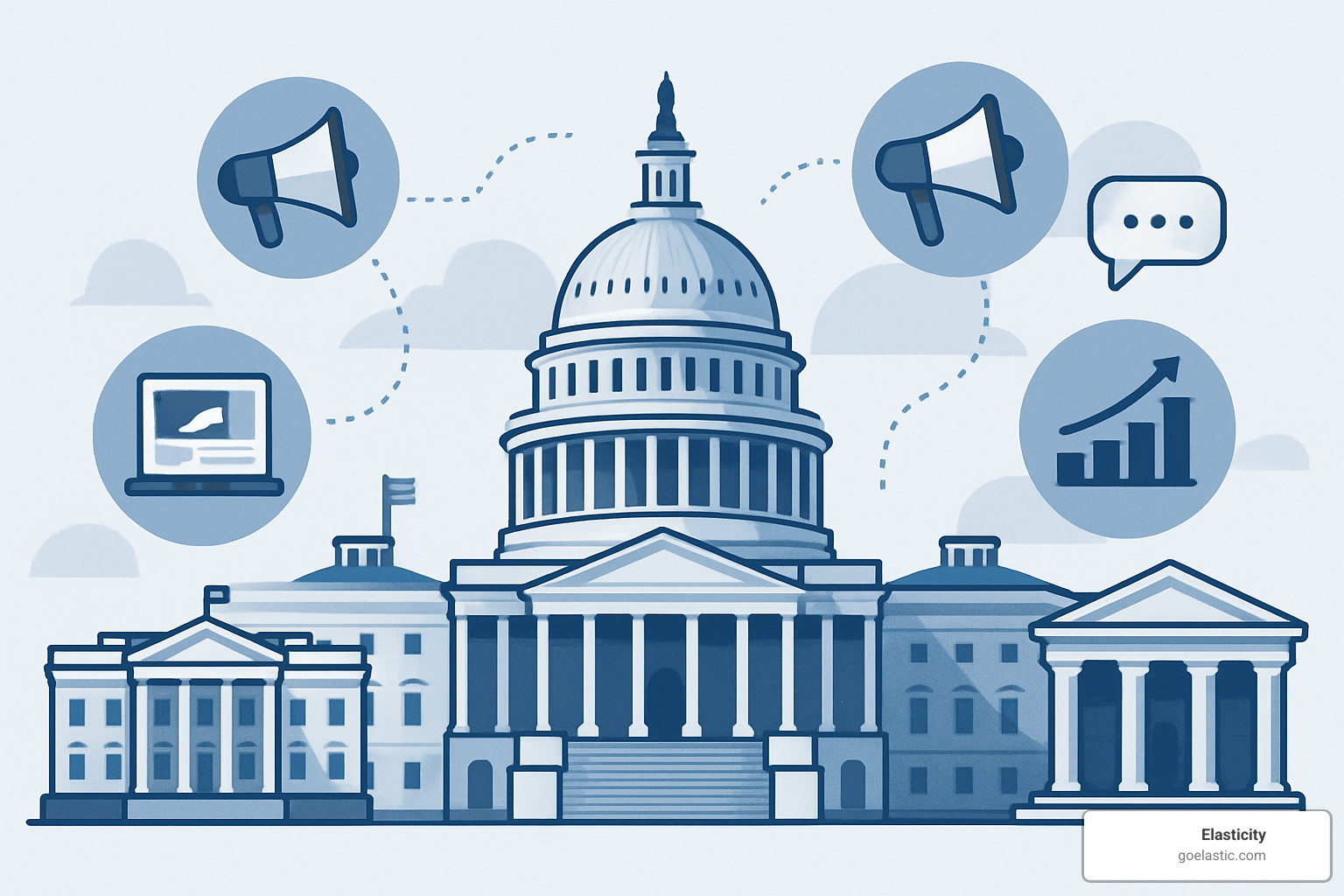Government marketing strategies: 10 Powerful Ways to Win in 2025
The Strategic Bridge: Government Marketing Simplified
Government marketing strategies are specialized approaches used to promote products and services to public sector organizations. These strategies differ significantly from commercial marketing due to unique procurement processes, compliance requirements, and decision-making structures.
Core Government Marketing Strategies:
– Align with agency missions – Frame offerings around solving specific government challenges
– Build trust through thought leadership – Create content demonstrating expertise in government issues
– Develop responsive digital presence – Optimize websites for government audiences and mobile devices
– Create custom capabilities statements – Customize messaging for specific contract opportunities
– Leverage strategic partnerships – Form teaming agreements with established contractors
– Focus on transparency and compliance – Ensure all communications adhere to government regulations
Government marketing involves navigating complex procurement landscapes where decisions are driven by strict regulations rather than pure market dynamics. According to a 2019 Forrester/Forbes report, the US federal customer experience remains weak and uneven, highlighting significant opportunities for organizations that can effectively communicate their value proposition to government entities.
The stakes are high—the federal government is the world’s largest buyer, spending billions annually on goods and services. Yet this market requires specialized approaches that acknowledge longer sales cycles, multiple stakeholders, and heightened scrutiny of public funds.
“Marketing to government is more than campaigns and design—it’s about forging real connections between people and their institutions,” notes one industry expert.
Successful government marketers understand that while private sector marketing focuses primarily on ROI and competitive advantage, public sector marketing must balance efficiency with transparency, accountability, and public service values.
I’m Jen Stamulis, and with over a decade of experience in driving growth across multiple sectors including government marketing strategies, I’ve seen how custom marketing approaches can transform an organization’s success in the public sector arena. My background in developing integrated media campaigns and customer segmentation strategies provides valuable insight into effectively reaching government decision-makers.

Government marketing strategies terms simplified:
– Government social media guidelines
– Public sector digital change
Government Marketing 101 & Knowing Your Audience
Before diving into specific strategies, it’s crucial to understand what makes government marketing unique and who exactly you’re trying to reach.
Government marketing is all about promoting products, services, or initiatives to government entities or the citizens they serve. This includes business-to-government (B2G) marketing for contractors seeking government business, as well as government-to-citizen (G2C) communication for public agencies.
How Government Marketing Differs from Commercial Marketing
When you’re marketing to government, you’re playing by a completely different set of rules. The government marketplace has its own rhythm and requirements that can feel like learning a new language.
| Element | Commercial Marketing | Government Marketing |
|---|---|---|
| Decision Process | Often single decision-maker | Multiple stakeholders and approvals |
| Sales Cycle | Weeks to months | Months to years |
| Primary Driver | Profit and ROI | Mission fulfillment and public value |
| Purchase Authority | Budget holder | Contracting officer following regulations |
| Messaging Focus | Benefits and competitive advantage | Compliance, past performance, and value |
| Content Needs | Product features and benefits | Detailed specifications and compliance documentation |
| Risk Tolerance | Innovation-focused | Risk-averse, precedent-based |
Let’s be honest – government procurement isn’t known for speed and simplicity. While a business might make a purchase decision in weeks, government contracts often take months or even years to finalize. This isn’t because they’re slow (though sometimes that’s true!), but because compliance requirements demand thorough vetting and multiple approvals.
“Not using digital marketing in the digital age would be silly for municipalities,” notes one public sector marketing expert. Yet many government entities and contractors still struggle with outdated approaches.
According to a recent Deloitte report, about 80% of government agencies are now prioritizing people-centric marketing and communication strategies. This shift recognizes that while checking all the compliance boxes matters, creating human connections is equally important.
When marketing to government, transparency isn’t just nice to have – it’s essential. Every dollar spent faces potential scrutiny, so your marketing must clearly demonstrate value, compliance, and alignment with the agency’s mission.
Key Government Decision-Makers and Influencers
Unlike the commercial world where you might need to convince one or two people, government purchasing decisions typically involve a small village of stakeholders. Knowing who influences these decisions is half the battle in government marketing strategies.

For B2G marketers, you’ll need to speak to several key players. Contracting officers hold the official authority to enter into agreements, but they’re guided by program managers who define requirements and evaluate technical solutions. For tech purchases, chief information officers often have significant input, while end-users – the folks who’ll actually use your product – can make or break implementation.
Don’t overlook small business specialists who serve as gatekeepers for set-aside contracts and diversity initiatives. And remember that prime contractors can become valuable partners for subcontracting opportunities if your company is newer to the government space.
For those in government communications reaching out to the public, your audience is equally diverse. Residents and citizens are your ultimate beneficiaries, but community leaders can amplify (or challenge) your messages in powerful ways. The media shapes public perception, while internal stakeholders need clear guidance to implement initiatives effectively. And always remember that oversight bodies like elected officials are watching closely.
“Government decision-makers receive hundreds of emails and letters every day,” one marketing expert points out. This reality underscores why your messaging must be crystal clear, concise, and immediately relevant. Public servants are busy people – respect their time by getting straight to the point about how you solve their problems.
Understanding these unique dynamics isn’t just helpful – it’s the foundation for any successful government marketing effort. By recognizing how government differs from commercial markets and mapping the complex web of stakeholders, you’ll be better equipped to craft strategies that actually work in this specialized environment.
Government Marketing Strategies That Win Contracts
Now that we understand the landscape, let’s explore specific government marketing strategies that drive results. Whether you’re a contractor seeking business or an agency communicating with constituents, these approaches can help you break through the noise.
Align with Agency Missions & Challenges
The most successful government marketing begins with deep understanding of agency priorities and pain points. This means going beyond surface-level research to truly grasp what keeps government leaders up at night.
When you study agency strategic plans, you get a window into their priorities, goals, and initiatives. Following budget appropriations reveals where money flows—and what truly matters to an agency. Monitoring policy priorities like executive orders and legislative mandates helps you understand what’s driving agency focus.
Tools like USAspending.gov are goldmines for analyzing past contracts and spending patterns. This research helps you identify the specific challenges each agency faces, because let’s face it—every government body has its own unique operational problems.
As one expert notes, “Government agencies don’t want to hear about products—they want insights into trends and challenges.” This means framing your marketing as solutions to specific problems, not just listing features and specifications.
For example, rather than promoting “cloud storage solutions,” successful marketers might address “secure data management that supports the Department of Defense’s zero-trust security initiative while reducing IT maintenance burdens on overtaxed staff.”
This alignment approach works just as well for government communicators. When explaining new programs to the public, connecting them to widely understood challenges or community priorities makes your message more relevant and engaging.
Build Trust with Transparent, Value-Driven Content
In government marketing, credibility is currency. Both contractors and agencies must build trust through content that demonstrates expertise, transparency, and value.
White papers addressing industry challenges and trends show you understand the bigger picture. Case studies (with proper approvals, of course) showcase your successful implementations. Custom capabilities statements custom to specific opportunities demonstrate your attention to detail. Webinars and educational resources position you as a helpful expert, while thought leadership articles in industry publications build your credibility.
According to research from Forbes and Forrester, companies that leverage thought leadership and content marketing are significantly more likely to be considered for government contracts. This approach positions you as a trusted advisor rather than just another vendor knocking on the door.
For government agencies, trust-building content might include success stories, transparent reporting on outcomes (both positive and negative), and clear explanations of decision-making processes.
“Content is king when educating and engaging citizens about government services,” notes a public sector marketing expert. This is particularly true as citizens increasingly expect the same level of information and transparency from government that they receive from private companies.
Leverage Digital Channels Effectively
Mobile device usage among government decision-makers is rapidly increasing, making responsive digital design a critical factor for government marketing strategies. A modern, accessible digital presence isn’t optional anymore—it’s essential.
Your website should function seamlessly across all devices—from desktop to smartphone. SEO optimization for government-specific search terms helps the right people find you. And don’t forget Section 508 compliance for accessibility—it’s not just a legal requirement, it’s the right thing to do.
Your social media presence should focus on platforms where your audience actually engages. Email campaigns should offer relevant, valuable content, not just sales pitches. Video content can explain complex concepts simply, making difficult subjects accessible.
“Many government websites look stuck in the early 2000s with blocky text and images,” observes one expert. This creates an opportunity for contractors with modern, user-friendly digital experiences to stand out from the crowd.
For government agencies, digital channels offer unprecedented opportunities to engage citizens where they are. As one source notes, “Social media is used daily by almost all constituents, making it one of the most effective channels for local government marketing and constituent engagement.”
More info about SEO for Government Websites
More info about Government Social Media Policy
More info about Public Sector Digital Marketing

Create Targeted Campaigns for Specific Contracts
One of the most effective government marketing strategies for contractors is developing campaigns specifically custom to individual contract opportunities. This targeted approach yields significantly better results than generic marketing.
Think of developing a targeted campaign like crafting a custom cover letter for your dream job. You’ll want to research the agency and opportunity thoroughly—study the solicitation, the incumbent, and what the agency really needs. Analyze who else might bid and what approaches they might take.
With this research in hand, develop a targeted value proposition that addresses the specific requirements. Create a capabilities statement custom to this specific opportunity—ideally a concise one-pager that speaks directly to what they need. Then implement a multi-channel outreach plan using the appropriate channels to reach decision-makers. Finally, track and measure your results so you can adjust as needed.
“Developing a targeted campaign for a specific contract is like crafting a custom cover letter for a job application,” explains one government marketing expert. “It should be customized, relevant, and focused on the specific needs of that opportunity.”
This approach takes more effort than generic marketing, but the results are worth it. Government contractors with dedicated, government-focused web presence and capabilities statements are significantly more likely to be considered for contracts than those without.

Partner & Network to Expand Reach
In the government marketplace, who you know matters as much as what you know. Strategic partnerships and networking are powerful government marketing strategies that can open doors to opportunities you might not access alone.
Teaming agreements with complementary contractors can help you offer a more complete solution. Subcontracting relationships with established prime contractors can get your foot in the door of larger contracts. Industry association membership gives you visibility and credibility, while government-industry events and conferences provide face-to-face networking opportunities.
Don’t overlook small business program participation and mentor-protégé relationships. These structured programs can provide valuable guidance and set-aside opportunities.
“Hosting a local fair booth to explain public service processes and gather citizen feedback” is one example of effective community engagement cited by experts. These in-person interactions build relationships that digital channels alone simply cannot match.
For government agencies, partnerships with local organizations, businesses, and community groups can significantly extend reach and credibility. As one source notes, “Nurturing partnerships with local organizations” is a key strategy for effective public service marketing.
The government contracting world, in particular, values established relationships and past performance. As one expert observes, “The role of networking and relationship building” cannot be overstated in successful government marketing—sometimes who you know really does open doors that would otherwise remain closed.
Measuring & Optimizing Performance and Building Trust
Let’s be honest – if you can’t measure it, you can’t improve it. This is especially true with government marketing strategies, where accountability isn’t just good business—it’s often mandated. Whether you’re a contractor tracking leads or an agency measuring citizen engagement, data should guide your every move.

Key Metrics & KPIs for Government Marketing
The government marketing world marches to the beat of a different drummer when it comes to metrics. While commercial businesses obsess over revenue and profit margins, government marketers need to track a more nuanced set of indicators.
If you’re marketing to government (B2G), your dashboard should spotlight pipeline development—how many opportunities are you identifying, and what’s their total value? Your win rate tells an important story too. Are you winning 10% of bids or 40%? That difference speaks volumes about your approach.
Cost per acquisition matters tremendously in government work. I’ve seen contractors spend $50,000 chasing a $40,000 contract—not exactly a recipe for success! Track your resources expended per win carefully.
Website engagement from .gov and .mil domains offers particular insight. When a contracting officer from the Department of Energy spends four minutes on your capabilities page, that’s worth noting. Similarly, capabilities statement downloads and webinar attendance can signal serious interest from government prospects.
For those on the government side communicating with citizens, your metrics palette looks a bit different. Citizen engagement with your content matters, as does program participation. Are people actually signing up for that new initiative you’ve been promoting?
“We found tracking sentiment in public feedback transformed our approach,” shared one county communications director I worked with. “Numbers only tell half the story—the tone tells the rest.”
Survey responses provide direct insights, while media coverage (both volume and tone) reflects how your message is resonating in the broader community. And don’t forget compliance rates—they show if your communication is actually changing behavior.
Incorporating Feedback & Continuous Improvement
The magic happens when you close the feedback loop. This isn’t just about collecting data—it’s about listening and adapting based on what you hear.
I love the approach one small federal contractor took: after every proposal submission, they requested a debrief regardless of outcome. Win or lose, they learned something valuable each time. Their win rate doubled in 18 months using this simple feedback mechanism.

Social media listening has become invaluable for government agencies. One city department noticed recurring complaints about confusing signage through their social monitoring. Rather than getting defensive, they launched a “Clear Signs” initiative, involving citizens in redesigning public information displays. The goodwill generated was worth ten times the project cost.
Analytics reviews should be regular events on your calendar. One agency communications team I advised started monthly “data parties” (complete with actual cake!) where they dug into what content performed best and why. Making data analysis fun transformed it from a chore to a highlight.
A/B testing isn’t just for e-commerce—it works beautifully in government communication too. Test different subject lines in citizen emails, various layouts for printed materials, or alternate phrasings for important announcements. Let the data guide your creative decisions.
According to Deloitte’s research, government organizations that accept people-centric strategies and actively incorporate feedback see dramatically better outcomes. This makes intuitive sense—marketing isn’t a monologue; it’s a conversation.
For government agencies especially, transparency about how feedback influences decisions builds tremendous trust. When citizens see their input reflected in actual changes, engagement skyrockets. One parks department created “You Spoke, We Listened” signage highlighting improvements made based on community input. Simple, but incredibly effective.
The bottom line? Measure what matters, listen carefully, and be willing to adapt. That’s how you build both effectiveness and trust in government marketing.
More info about Services: Analytics & Insights
Frequently Asked Questions about Government Marketing Strategies
What makes government marketing different from B2B or B2C?
When it comes to Government marketing strategies, you’re entering a whole different ballgame compared to commercial marketing.
First, compliance isn’t just important—it’s everything. Government marketers steer a maze of regulations about procurement, ethics, and transparency that would make most B2B marketers’ heads spin. These aren’t just guidelines; they’re non-negotiable requirements.
Public accountability creates another layer of complexity. Every dollar spent is a taxpayer dollar, which means your marketing efforts face heightened scrutiny. As one expert puts it, “Traditional marketing strategies often fall short in the public sector due to the need for transparency and trust.”
The pace is also dramatically different. While commercial deals might close in weeks or months, government procurement cycles frequently stretch 12-18 months or longer. This marathon (not sprint) mentality requires patience and persistent nurturing of relationships.
Decision-making in government rarely comes down to a single person saying “yes.” Instead, you’ll need to convince multiple stakeholders across various departments, each with their own priorities and concerns. Building consensus becomes an essential skill.
Finally, while commercial marketing focuses on profit margins and competitive advantage, government marketing must speak to mission fulfillment and public value. Your messaging needs to demonstrate how your solution helps agencies better serve citizens—not just save money or improve efficiency.
Which digital channels work best for reaching government buyers?
Finding the right digital channels to reach government decision-makers requires strategic thinking about where these professionals actually spend their time.
LinkedIn stands out as particularly valuable for federal employees and contractors. Government professionals use this platform not just for networking but for staying informed on industry trends and challenges. Creating thoughtful, valuable content here can position you as a trusted resource.
Government-specific forums and publications like GovLoop or Government Executive offer targeted reach to engaged public sector professionals. These specialized platforms often provide more focused attention than broader channels.
Email marketing remains surprisingly effective, especially when your content directly addresses specific pain points or challenges. Government inboxes are particularly crowded, so your subject lines and content must be exceptionally relevant.
Webinars and virtual events have become increasingly important, offering education while generating qualified leads. These formats allow you to demonstrate expertise in a non-sales environment that government professionals appreciate.
“Mobile device usage among government decision-makers is rapidly increasing,” notes one industry source. This trend makes mobile-responsive websites essential rather than optional. Your site must perform flawlessly across all devices.
For government agencies communicating with citizens, effective channels include popular social platforms, email newsletters, mobile apps, text messaging for urgent updates, and video content that simplifies complex programs.
The golden rule? Meet your audience where they are rather than where it’s convenient for you to reach them.
How do we prove ROI to leadership?
Demonstrating the return on investment for your Government marketing strategies requires both art and science—especially when leadership wants hard numbers to justify marketing spend.
For B2G marketers, focus on metrics that directly connect to business outcomes. Pipeline growth shows you’re identifying more qualified opportunities. Contract value demonstrates the actual revenue impact of your marketing efforts. Improved win rates over time prove your messaging is becoming more effective. And tracking customer acquisition costs helps show increasing efficiency in your marketing operation.
Government communicators face a different challenge. Your ROI metrics might include program participation rates (are more citizens using your services?), reduced service costs (are digital channels decreasing the need for costly in-person interactions?), and improved citizen satisfaction measured through surveys and feedback.
The most compelling ROI presentations don’t just show numbers—they tell stories. Instead of simply reporting that website traffic increased 25%, explain how that increased traffic led to specific program outcomes or contract wins. Connect the dots between marketing activities and real-world impact.
As one public sector marketing expert notes, “Using analytics tools to monitor website traffic, social media metrics, and campaign ROI” provides the foundation for these conversations with leadership. But the human element of interpretation—explaining why these metrics matter—is equally important.
Some of the most valuable outcomes, like trust and relationship-building, can’t be fully captured in metrics. Balance your quantitative data with qualitative insights about how your marketing efforts are changing perceptions and opening doors.

Conclusion
Navigating government marketing strategies isn’t quite like any other marketing challenge. It’s a unique landscape with its own rules, stakeholders, and values—whether you’re a contractor hoping to win business or an agency connecting with citizens.
Throughout this guide, we’ve explored how successful government marketers stand apart. They don’t just understand roles and regulations—they understand people. They recognize that behind every procurement decision or citizen interaction is a human being trying to solve real problems.
The most effective government marketers build their approach on seven core principles:
They deeply understand their audiences, looking beyond org charts to uncover the actual challenges and priorities of the people making decisions. They align with agency missions, positioning their offerings as direct solutions to the problems that matter most. They build trust through transparency, knowing that in government, credibility is everything.
Successful marketers also leverage appropriate digital channels to meet audiences where they already are. They create targeted, relevant content that speaks directly to specific opportunities or needs. They develop strategic partnerships that extend their reach and credibility. And they measure and optimize continuously, using real data to drive better results over time.
As government continues evolving its approach to citizen engagement and procurement, we must evolve alongside it. The increasing emphasis on digital tools, personalized communication, and measurable outcomes brings both new challenges and exciting possibilities for those willing to adapt.
At Elasticity, we’ve walked this road with countless organizations navigating the complex government landscape. With offices spanning from Washington D.C. to Los Angeles, we bring local insights to national challenges. Our team understands that effective government marketing strategies aren’t just about checking boxes—they’re about making meaningful connections that drive real results.
Whether you’re looking to win more government contracts or better engage with your constituents, we’re here to help you cut through the complexity. Our expertise in public sector digital marketing, compelling content, and insightful analytics can help you reach the right people with the right messages.
Ready to take your government marketing to the next level? Let’s talk about creating a strategy that truly connects with your audience and delivers the outcomes you need.
More info about marketing, advertising & brand design services


